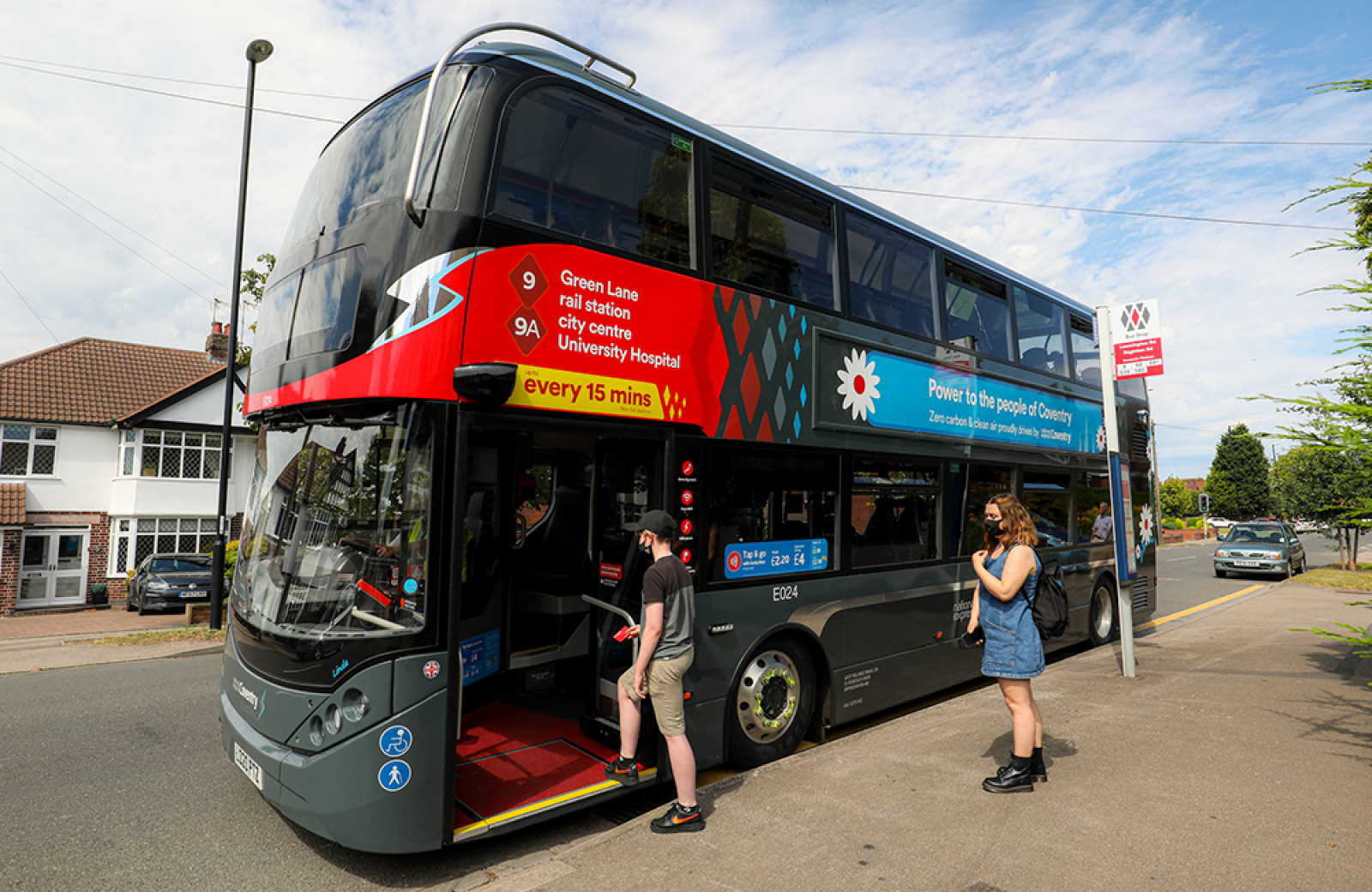Zero emission buses need a bigger plan

Berlin, 2013
Nine years ago I was at an event in the Schoenberg district of Berlin, in what was a gas holder and is now repurposed as a conference centre. As well as being effortlessly Berlin cool, the gas holder also symbolises the energy transition as it is part of a wider buzzing former industrial complex called EUREF, where businesses big and small, start-ups and researchers are working on a host of energy, mobility and sustainability projects.
Plug in vehicles are being built and tested on site. I’m shown a digital panel which shows, in real time, the energy the site is generating from its own turbines; what energy is being imported or exported from the site or used within the site in vehicles; and the relative costs of different decisions you might make and the implications of the weather forecasts.
The campus allows cross-fertilisation of ideas and projects between those on site. It’s grown since and now 5,000 people work, research and study there in more than 150 enterprises, institutions and start-ups. And this is Germany so the local authority is also part of it. Innovations can be trialled and adopted by the municipalities beyond the boundaries of the campus. EUREF blows my tiny mind. I keep going on about it.
Birmingham/Coventry, October 2022
A constant throughout the pandemic, and since, has been regular Teams calls of UTG member bus leads. Trapped behind our screens as a now battle-hardened crew, we have dealt with everything the pandemic has thrown at us.
We told people to stay away from buses during Covid restrictions, told them to come back afterwards; kept the wheels turning as the clock approached midnight on government funding support; shared approaches on keeping bus staff and passengers safe. And now, at a bus stop outside Birmingham Moor Street station, we get to see each other for the first time in three dimensions since it all began. Recalibrating our brains to take account of the fact that each other’s faces aren’t screen flat - they are part of three dimensional heads.
We are heading for Tyseley Energy Park which turns out to be a UK comparator to Berlin’s EUREF. On a large site (well positioned in an industrial and transport area), the park is home to an expanding nexus of low and zero carbon power, transport, heat waste and recycling projects. This includes a biomass power plant, a vehicle refuelling station (able to fill up vehicles with hydrogen, biodiesel, CNG and electricity) as well as space for low carbon focussed SMEs to base themselves as part of an Energy Innovation Centre. And that’s for starters as more facilities and initiatives are added. There’s the same onwards and upwards (let’s try this) feel as in Berlin’s EUREF.
We move on (by ZEB of course) to Coventry’s Pool Meadow bus depot for some show-and-tell about Coventry Electric Bus City. Inside the hulking depot the transition to electric is happening in front of our eyes as we gather round the latest boxfresh electric double decker. Interestingly, for the first time we hear about three ways in which the advantages of zero emission buses extend beyond the obvious environmental benefits.
Firstly, drivers prefer them. ZEBs make for a smoother driving experience making the working day that little bit easier. Meanwhile maintenance and fleet management is less about spanners than it is about laptops. It feels like work of the future rather than of the past. And in a tight labour market this can only help with recruitment and retention.
Secondly, the smoother ride is doing something for passengers too. We hear that routes with electric buses are performing better for patronage than those with diesel buses (despite the bodywork being the same). Perhaps this is connected with something we don’t talk enough about when we talk about buses. There is a strong focus on what buses look like on the outside (branding and liveries) and internal bells and whistles (Wi-Fi, leather seats etc), but this masks a lack of interest in ride quality. And the ride quality of a typical modern, lightweight bus is not great.
I don’t drive so I use a lot of buses and I spend a lot of time making the case for more people to do the same. But usually when I’m on a bus, I’ve had enough after about half an hour. Had enough of rattling about like a loose coin in a washing machine spin cycle. And that’s without the discordant symphony of rattling windows and anything else where the screws holding it in place aren’t 100% tightened.
All of this is made much worse if it’s sunny and those big beautiful picture windows that are one of the delights of bus travel start to create a greenhouse effect. I get that lightweight means less fuel consumption (and that air con has multiple challenges in terms of costs, weight, reliability) but still, is ride quality an issue that we need to talk more about? And perhaps the benefits of the better ride quality of electric buses is a factor in the patronage phenomena being observed in Coventry?
And then there’s the third and final co-benefit. Smoother driving is leading to less accidents (including trips and falls on board).
So, given all these direct (greener) and indirect benefits (safer, smoother and more popular), where are we on the transition to zero emission buses and how do we scale up? At present the transition feels undercooked. There are many reasons behind this but among the key ones is the stop/start approach to funding based on slow moving ‘knobbly knees’ contests for local transport authorities which in turn mitigates against collaboration, leads to messy order books for manufacturers and a proliferation of different specifications.
All of which also means higher ZEB prices - which in turn deters and slows orders.
At the same time there is a problem not just with putting the vehicles on place but also with the green energy they need. Getting the buses hooked up to the mains can be a difficult and expensive project as the electricity distribution sector operates on a ‘first come, first served’ basis and in some areas can be difficult and expensive to deal with.
There’s a better approach which lies tantalisingly in reach. If we could align the new diesel buses end date with BSOG (Bus Service Operators Grant) reform and with a longer term capital support programme this could also be used to ensure more consistent order books for manufacturers based on more standardised specifications. This in turn should drive down prices which in turn would mean that capital and revenue grant incentives for ZEBs could also be switched off sooner. This, combined with a more united front to bring the electricity distribution companies in line, might create the conditions for bringing in more private investment.
City of London, October 2022
I like a professional event where I don’t know that many people already (and what they are going to say). It means I’m probably going to learn something new. And at the Net Zero Investment Summit (part of the Cities Commission for Climate Investment’s efforts to secure the necessary finance to support the transition to net zero) at Guildhall in the City of London, on October 25, I learnt more about what makes the ‘investment community’ tick.
Alongside local government, chief executives are the people who invest your pension funds, who are responsible for your city’s crane count or who, for whatever reason, can find the money when they see the opportunity that’s just right for them - that plays to their niche or a hunch. All of them have an imperative to invest money and some of them want to skew that investment in the direction of decarbonisation. The problem is the investment community speaks a different language from local government and without common understanding it's hard to build the trust necessary to see if there is an opportunity here that works for both sides. But if there’s a clearer framework for decarbonising bus fleets, then perhaps an investable proposition could emerge?
It feels to me that if we are to decarbonise the bus fleet quickly, then this will require all the key parties to think bigger and act faster. We have the justification, the kit, the energy and potentially more money than we thought we had. We just need a bigger plan.
Jonathan Bray is Director at the Urban Transport Group
This blog originally appeared in Passenger Transport magazine

